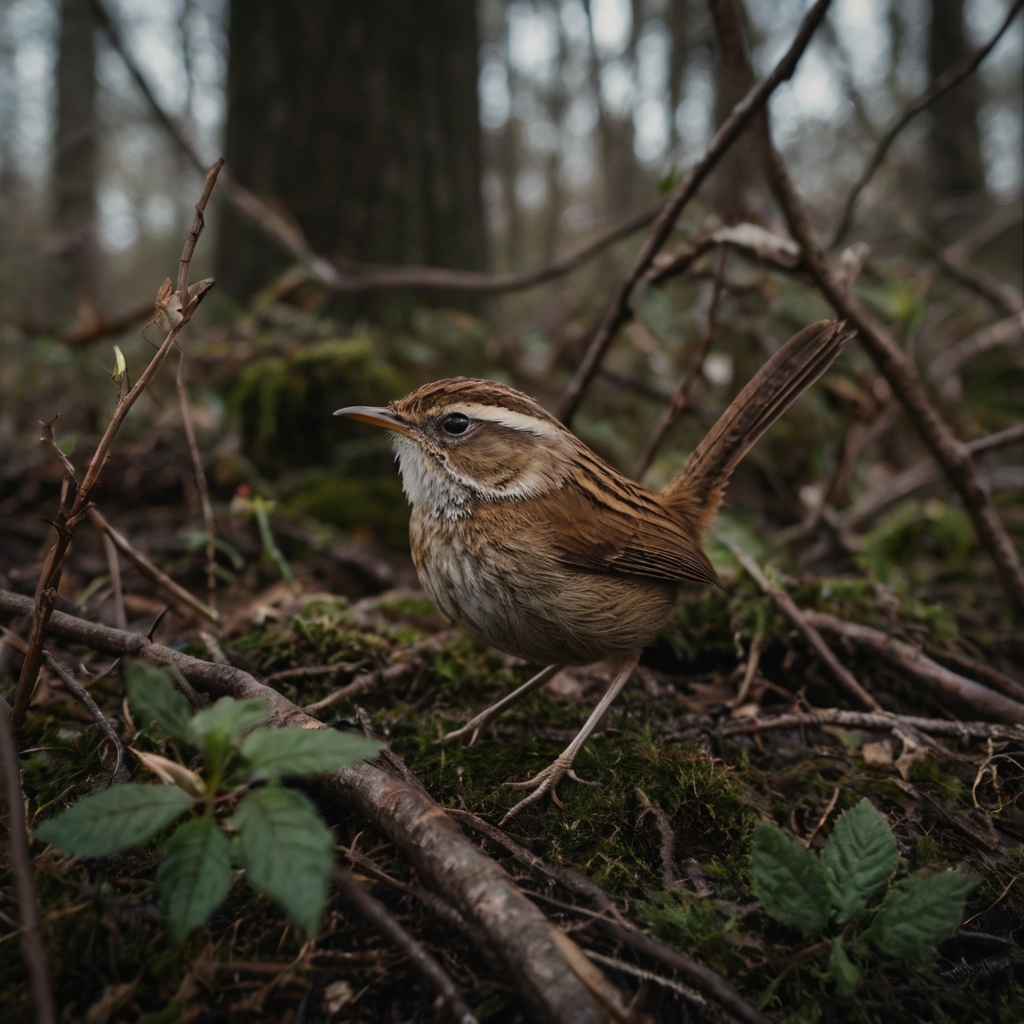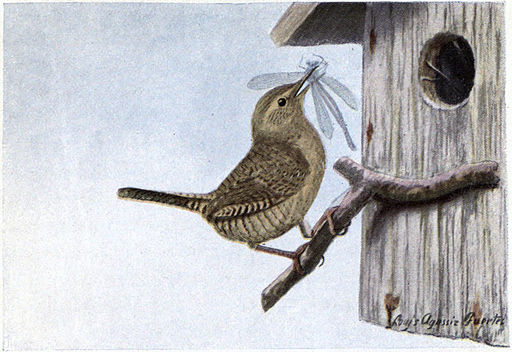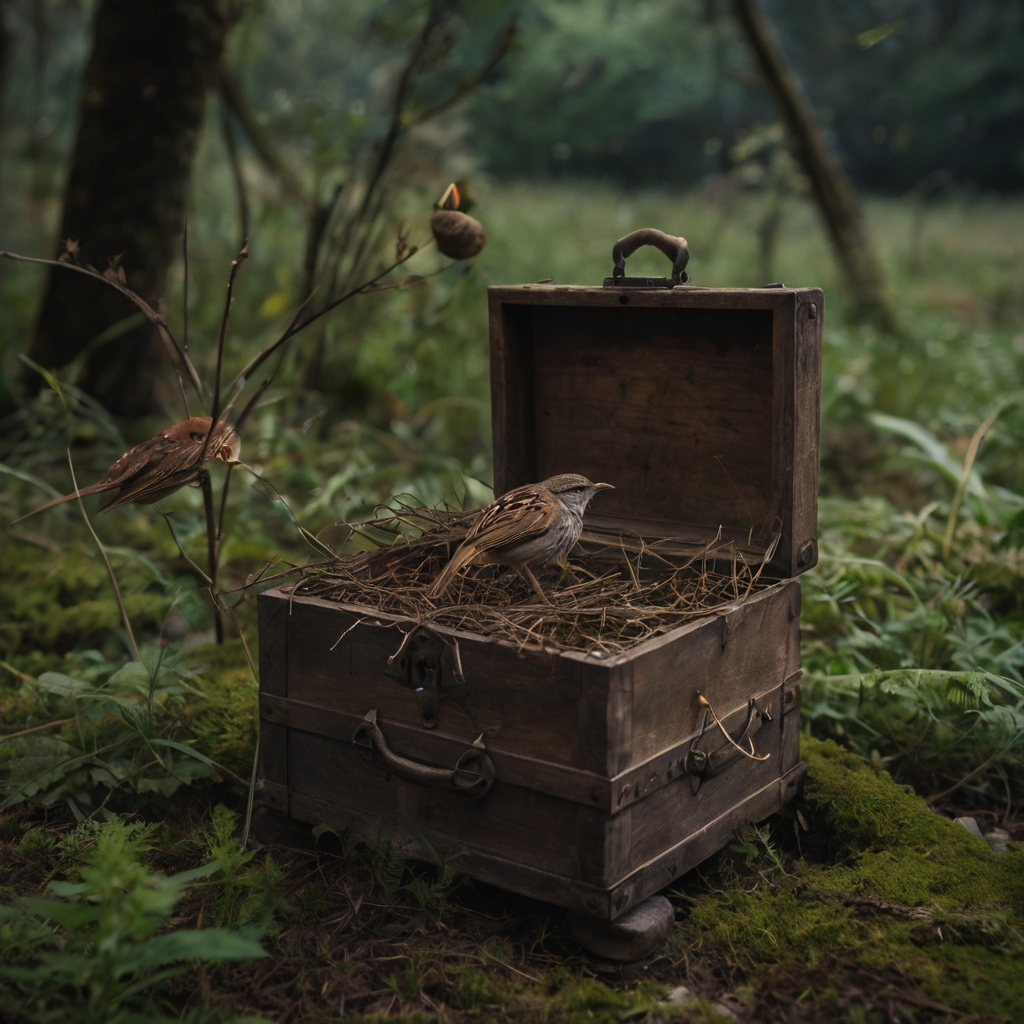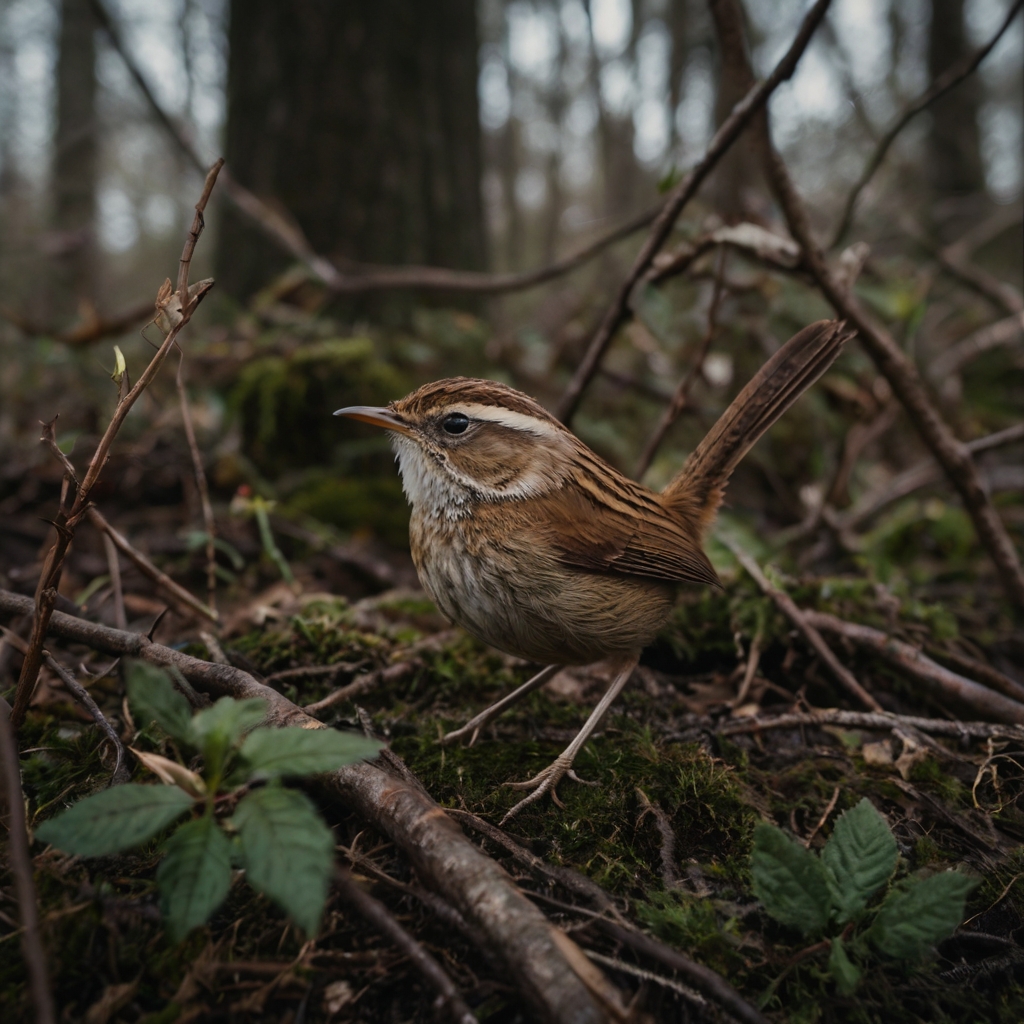The unassuming Wren (Troglodytes troglodytes) may be tiny in size, weighing just 6 grams, but its story is bigger than its small stature. This diminutive bird holds a profound place in the cultural narratives of various societies and weaves its way into folklore and legend with symbolism and cultural significance.
One of the striking features of the Wren is its behavior. Often found hopping about on the ground and near undergrowth in search of its insect diet, the Wren’s movements are subtle yet purposeful. Despite its small size, its song is surprisingly loud, a characteristic that often leads to it being heard but not easily seen, blending seamlessly into its environment. Even the bird’s scientific name, Troglodytes troglodytes, meaning “cave dweller,” adds an intriguing layer to its identity.
The Wren’s camouflaging abilities and its elusive nature have contributed to its prominence in folklore and myth across cultures. In many tales, the Wren is portrayed as a symbol of stealth, agility, and adaptability, traits that are admired and revered. Its ability to navigate the undergrowth and blend into its surroundings has inspired stories of cunning and resourcefulness.
The Wren’s presence in cultural narratives extends beyond its physical characteristics. Its name, behavior, and symbolic attributes have woven a history of stories and myths that highlight the bird’s resilience, adaptability, and survival instincts. As a result, the Wren has become more than just a small bird; it is a symbol of ingenuity and to the idea that size does not define strength or significance in nature and storytelling.

The Wren in Celtic and British Folklore
Celtic Mythology: The King of All Birds
At the heart of Celtic mythology lies the captivating tale of the wren’s cunning ascent to the esteemed title of the “King of All Birds.” This legendary story unfolds with a grand contest among avian creatures, each vying for sovereignty based on their ability to soar to the greatest heights. Initially, the majestic eagle appeared poised for victory as it ascended with majestic grace, its powerful wings carrying it skyward.
However, what seemed like an inevitable triumph for the eagle took an unexpected turn when a tiny wren, hidden within the eagle’s plumage, revealed itself at a crucial moment. With swift and calculated precision, the wren launched itself into the open air, soaring even higher than the mighty eagle. In a breathtaking display of cunning and strategy, the wren claimed the crown, outsmarting its larger counterpart and securing its place as the “King of All Birds.”
This ancient narrative serves as a powerful archetype, embodying the wren as a symbol of intelligence, strategy, and triumph against adversity. The wren’s victory is not won through sheer might but through the clever manipulation of circumstances, showcasing the potency of intellect and resourcefulness.
The tale of the wren’s ascent to kingship resonates across generations, echoing themes of underdog resilience and the transformative power of wit. It is a timeless testament to the notion that size and strength are not always the determining factors of success; rather, it is often the cleverness and ingenuity of individuals that lead to triumph in the face of challenges.
Through this narrative, the wren emerges not only as a legendary figure in Celtic folklore but also as a universal symbol of the indomitable spirit and the enduring belief in the ability to overcome obstacles through strategic thinking and cunning maneuvers
British Folklore: Tales of Cunning and Ingenuity
Across the British Isles, folklore is rich with tales that highlight the wren’s craftiness and resourcefulness. This tiny bird is often depicted as a trickster figure, navigating perilous situations with astute wit and clever maneuvers. These stories not only entertain but also carry valuable moral lessons, emphasizing the virtues of ingenuity and quick thinking.
In these narratives, the wren outsmarts larger predators and overcomes daunting challenges through its cunning strategies. Whether it’s tricking a cat or eluding a hawk, the wren’s ability to outwit its adversaries makes it a beloved character in folklore. These tales serve as reminders of the power of intelligence and adaptability, traits highly valued in societies that prize resourceful problem-solving.
The wren’s portrayal in British folklore as a clever and nimble creature has made it a cultural emblem of intelligence and adaptability. Its stories resonate with audiences of all ages, celebrating the triumph of wit over brawn and the resilience of the underdog. Through these narratives, the wren has earned a place of honor in the collective imagination, embodying timeless lessons of cunning and resourcefulness that continue to inspire and captivate.

The Wren in Seasonal Traditions
Wren Day: A Celebration of Cunning and Community
Wren Day, observed in Ireland on December 26th, also known as St. Stephen’s Day, is a vibrant and cherished tradition that intertwines ancient customs with modern festivities. At the heart of this celebration is the wren, a tiny bird with a mighty legacy, symbolizing resilience, survival, and the spirit of community.
The origins of Wren Day are deeply rooted in both pagan and Christian traditions, creating a unique tapestry of cultural significance. In ancient times, villagers would embark on a symbolic “hunt” for the wren, a tradition believed to date back to pre-Christian rituals honoring the winter solstice. The wren, with its survival instincts and cleverness, became a symbol of hope and endurance during the darkest days of winter.
As Christianity spread across Ireland, Wren Day became associated with St. Stephen’s Day, commemorating the martyrdom of St. Stephen. This blending of pagan and Christian elements added layers of meaning to the celebration, symbolizing the transition from winter’s darkness to the burgeoning light of spring.
Modern iterations of Wren Day continue to honor this rich heritage while adapting to contemporary times. While the actual hunting of wrens has ceased, communities across Ireland come together on December 26th to celebrate with music, dance, and colorful processions. A symbolic wren, often crafted from straw or other materials, takes center stage, serving as a reminder of the bird’s legacy and the resilience it represents.
The festive spirit of Wren Day extends beyond mere revelry; it is a tribute to nature’s tenacity and the enduring bonds of community. Through songs, stories, and communal gatherings, participants pay homage to the wren’s cleverness and adaptability, drawing inspiration from its ability to thrive in challenging environments.
In essence, Wren Day is more than just a festive occasion; it is a testament to the timeless themes of survival, renewal, and the enduring spirit of celebration that unites people across generations and cultures.
Manx Mystique: The Wren’s Solstice Serenade
On the Isle of Man, the wren holds a sacred role in solstice celebrations, deeply rooted in ancient rituals that mark the rebirth of light and the turning of the seasons. In Manx folklore, the wren is intricately intertwined with themes of renewal, protection, and the cyclical rhythms of nature.
The tale of Tehi Tegi is about a fairy who enchants men to lure them to the island. When they try to capture her she turns into a wren and flies away.
Throughout the centuries, songs and tales have recounted the wren’s significance as a guardian spirit during the darkest days of winter. As the sun reaches its lowest point and the days grow shorter, the wren emerges as a symbol of hope and resilience amid adversity. Its small size belies its strength, embodying the belief that even the smallest of creatures can endure and thrive in challenging times.
The Manx people embrace the wren as a harbinger of brighter days ahead. In solstice celebrations and festive rites, the wren’s symbolism is woven into the fabric of tradition, honoring the timeless cycles of life and nature’s enduring resilience.
During these celebrations, the wren is often depicted in traditional art and crafts, symbolizing protection and the promise of renewal. Songs and dances pay homage to the bird’s significance, with lyrics that speak of its role as a guardian of the land and a bringer of good fortune.
The rituals associated with the wren on the Isle of Man reflect a deep reverence for nature and the interconnectedness of all living beings. As the wheel of the year turns and the seasons change, the wren’s presence serves as a reminder of the ever-changing yet cyclical nature of life.
In essence, the wren in Manx folklore embodies themes of hope, resilience, and the enduring spirit of renewal. Its sacred role in solstice celebrations underscores the profound connection between humans and the natural world, fostering a deep sense of reverence and gratitude for the cycles of life that sustain us all.

Wren’s Mystical history
Wren’s in Myth and Legend
In Irish folklore, the wren occupies a unique and enchanting place, often associated with the mystical realm of fairies and magical creatures. This connection with the enchanted world adds a layer of mystery and wonder to the bird’s folklore, blurring the boundaries between the ordinary and the extraordinary.
One of the aspects of Irish lore is the belief that wrens have the ability to assume human form or aid heroes in their quests. Stories abound of wrens transforming into humans to deliver important messages or guide travelers through perilous journeys. This magical aspect of the wren’s folklore speaks to its role as a bridge between the mundane and the enchanted, embodying the idea that the natural world is intertwined with realms of magic and fantasy.
Similarly, medieval European folklore weaves the wren into narratives of magical creatures and hidden realms. Despite its small size, the wren is often portrayed as a creature of great significance, capable of extraordinary feats and possessing mystical powers. Its ability to navigate between different worlds, whether as a messenger for fairies or a companion to mythical heroes, symbolizes the notion that true power often lies in unexpected places.
The wren’s folklore in both Irish and medieval European traditions reminds us of the interconnectedness of all things and the wonder that lies just beyond everyday reality. Its small stature belies a world of enchantment and possibility, inspiring tales of wonder and awe that continue to captivate imaginations across generations. In these stories, the wren transcends its physical form, becoming a symbol of magic, mystery, and the enduring allure of the fantastical.
The Wren in Norse Mythology
Within Norse mythology, the wren takes on a significant role symbolizing wisdom, foresight, and agility, aligning perfectly with the Norse pantheon’s reverence for knowledge and cunning. Despite its small size, the wren’s keen observation and swift movements are celebrated as manifestations of intelligence and agility, traits highly esteemed in Norse cultures.
Legends within Norse mythology depict the wren as a messenger of the gods, entrusted with delivering crucial insights and warnings to mortals. Its ability to navigate between worlds and communicate with divine beings underscores the belief in nature’s inherent wisdom and the interconnectedness of all living beings.
The wren’s association with wisdom and foresight is further exemplified in its symbolic portrayal in Norse art and storytelling. In depictions, the wren is often shown perched on the shoulder of Odin, the All father and god of wisdom, as if imparting secret knowledge or offering guidance. This imagery reinforces the wren’s role as a conduit for divine wisdom and a symbol of the interconnectedness between the mortal and divine realms.
The wren’s presence in mythological narratives serves as a reminder of the importance of keen observation and swift action in navigating life’s challenges. Its ability to swiftly dart through branches and undergrowth, evading predators and seizing opportunities, embodies the Norse ideals of agility and intelligence in overcoming obstacles.
The wren emerges as a powerful symbol representing wisdom, foresight, agility, and the interconnected nature of the universe. Its presence in mythological narratives underscores the belief in the inherent wisdom of nature and the divine guidance that permeates the world, making the wren a revered figure in Norse cultures and a timeless emblem of intelligence and insight.

Cultural Variations: The Wren’s Global Journey
Native American traditions
While the wren’s significance in Native American folklore varies among tribes and regions, certain tribes hold this bird in high esteem for its industrious nature. Stories depict the wren as a symbol of diligence and perseverance, embodying the spirit of hard work and resourcefulness that are valued in many Native American cultures.
In some tribal lore, the wren’s cleverness is celebrated through tales of its feats in outsmarting larger animals or overcoming daunting challenges. These narratives highlight the universal admiration for resilience and ingenuity, qualities that transcend cultural boundaries.
The wren’s portrayal in Native American folklore underscores the cultural appreciation for traits such as diligence, perseverance, and cleverness, making it a symbol of inspiration and admiration across various indigenous communities.
French Folklore
French folklore presents a unique perspective on the wren, highlighting its bravery and protective instincts. Stories depict the wren as fiercely defending its nest and offspring, confronting adversaries with courage that belies its small size.
This portrayal of the wren as a symbol of bravery resonates with broader themes of valor and determination found in French cultural narratives. The bird’s tenacity in defending its domain inspires admiration and serves as a metaphor for facing challenges with unwavering resolve.
Embodying the spirit of courage and resilience, reminding us that bravery comes in all sizes and that determination can overcome even the most formidable obstacles.

In closing
The wren, despite its tiny size, holds immense significance in folklore and mythology across various cultures. These tales collectively portray the wren as a symbol of intelligence, courage, and survival across diverse cultural narratives.
In Celtic mythology, it is revered as the “King of All Birds,” earning this title through cleverness and wit in a legendary contest. British folklore celebrates the wren for its craftiness and quick manoeuvres, often outsmarting larger predators through clever tactics. In Irish folklore, the wren is associated with fairies and magical realms, embodying a bridge between the mundane and the enchanted. Medieval European folklore also portrays the wren as a creature of great significance, capable of extraordinary feats and possessing mystical powers. In Norse mythology, the wren symbolizes wisdom, foresight, and agility, serving as a messenger of the gods and embodying the interconnectedness of all living beings. Native American folklore values the wren for its industrious nature, while French folklore highlights its bravery and protective instincts..
The wren’s presence in folklore goes beyond geographic boundaries and cultural divides bringing symbolism that follows the themes of intelligence, resilience,and magic. The wren’s tales leave us to ponder the deeper meanings hidden within the seemingly ordinary. Its small stature belies its profound legacy in symbolism, reminding us that greatness often resides in the subtle nuances of nature and enduring folk tales.

